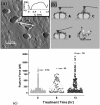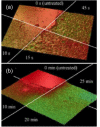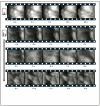Nanocharacterization in dentistry
- PMID: 20640166
- PMCID: PMC2904930
- DOI: 10.3390/ijms11062523
Nanocharacterization in dentistry
Abstract
About 80% of US adults have some form of dental disease. There are a variety of new dental products available, ranging from implants to oral hygiene products that rely on nanoscale properties. Here, the application of AFM (Atomic Force Microscopy) and optical interferometry to a range of dentistry issues, including characterization of dental enamel, oral bacteria, biofilms and the role of surface proteins in biochemical and nanomechanical properties of bacterial adhesins, is reviewed. We also include studies of new products blocking dentine tubules to alleviate hypersensitivity; antimicrobial effects of mouthwash and characterizing nanoparticle coated dental implants. An outlook on future "nanodentistry" developments such as saliva exosomes based diagnostics, designing biocompatible, antimicrobial dental implants and personalized dental healthcare is presented.
Keywords: afm; bacterial adhesins; biofilms; dentine tubule; dentistry; implants; interferometry; nano-characterization; nanodentistry.
Figures












Similar articles
-
Nanodentistry: A Paradigm Shift-from Fiction to Reality.J Indian Prosthodont Soc. 2011 Mar;11(1):1-6. doi: 10.1007/s13191-011-0062-0. Epub 2011 Apr 20. J Indian Prosthodont Soc. 2011. PMID: 22379298 Free PMC article.
-
Clinical efficacy of a specifically targeted antimicrobial peptide mouth rinse: targeted elimination of Streptococcus mutans and prevention of demineralization.Caries Res. 2011;45(5):415-28. doi: 10.1159/000330510. Epub 2011 Aug 19. Caries Res. 2011. PMID: 21860239 Free PMC article.
-
A quaternary ammonium silane antimicrobial triggers bacterial membrane and biofilm destruction.Sci Rep. 2020 Jul 3;10(1):10970. doi: 10.1038/s41598-020-67616-z. Sci Rep. 2020. PMID: 32620785 Free PMC article.
-
Does assessment of microbial composition of plaque/saliva allow for diagnosis of disease activity of individuals?Community Dent Oral Epidemiol. 1997 Feb;25(1):76-81. doi: 10.1111/j.1600-0528.1997.tb00902.x. Community Dent Oral Epidemiol. 1997. PMID: 9088695 Review.
-
Can the ecology of the dental biofilm be beneficially altered?Adv Dent Res. 2009;21(1):69-73. doi: 10.1177/0895937409335641. Adv Dent Res. 2009. PMID: 19717412 Review. No abstract available.
Cited by
-
Surface degradation effects of carbonated soft drink on a resin based dental compound.Heliyon. 2021 Mar 8;7(3):e06400. doi: 10.1016/j.heliyon.2021.e06400. eCollection 2021 Mar. Heliyon. 2021. PMID: 33869827 Free PMC article.
-
Nanodentistry: A Paradigm Shift-from Fiction to Reality.J Indian Prosthodont Soc. 2011 Mar;11(1):1-6. doi: 10.1007/s13191-011-0062-0. Epub 2011 Apr 20. J Indian Prosthodont Soc. 2011. PMID: 22379298 Free PMC article.
-
Illuminating the oral microbiome and its host interactions: tools and approaches for molecular ecological studies.FEMS Microbiol Rev. 2023 Jan 16;47(1):fuac052. doi: 10.1093/femsre/fuac052. FEMS Microbiol Rev. 2023. PMID: 36564013 Free PMC article. Review.
-
Role of exosomes in the communication and treatment between OSCC and normal cells.Heliyon. 2024 Mar 20;10(7):e28148. doi: 10.1016/j.heliyon.2024.e28148. eCollection 2024 Apr 15. Heliyon. 2024. PMID: 38560136 Free PMC article. Review.
-
Surface Morphology and Tooth Adhesion of a Novel Nanostructured Dental Restorative Composite.Materials (Basel). 2016 Mar 16;9(3):203. doi: 10.3390/ma9030203. Materials (Basel). 2016. PMID: 28773327 Free PMC article.
References
-
- Freitas RA., Jr Nanodentistry. J. Am. Dent. Assoc. 2000;131:1559–1565. - PubMed
-
- Dufrene YF. Towards nanomicrobiology using atomic force microscopy. Nat. Rev. Microbiol. 2008;6:674–680. - PubMed
-
- Kasas S, Fellay B, Cargnello R. Observation of the action of penicillin on bacillus-subtilis using atomic-force microscopy - technique for the preparation of bacteria. Surf. Interf. Anal. 1994;21:400–401.
Publication types
MeSH terms
Substances
LinkOut - more resources
Full Text Sources
Other Literature Sources
Miscellaneous

